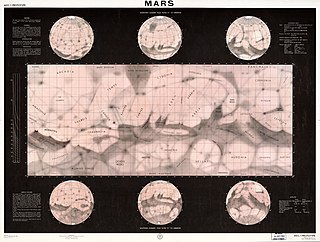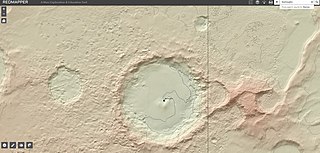
The Mariner program was conducted by the American space agency NASA to explore other planets. Between 1962 and late 1973, NASA's Jet Propulsion Laboratory (JPL) designed and built 10 robotic interplanetary probes named Mariner to explore the inner Solar System – visiting the planets Venus, Mars and Mercury for the first time, and returning to Venus and Mars for additional close observations.

Mariner 4 was the fourth in a series of spacecraft intended for planetary exploration in a flyby mode. It was designed to conduct closeup scientific observations of Mars and to transmit these observations to Earth. Launched on November 28, 1964, Mariner 4 performed the first successful flyby of the planet Mars, returning the first close-up pictures of the Martian surface. It captured the first images of another planet ever returned from deep space; their depiction of a cratered, dead planet largely changed the scientific community's view of life on Mars. Other mission objectives were to perform field and particle measurements in interplanetary space in the vicinity of Mars and to provide experience in and knowledge of the engineering capabilities for interplanetary flights of long duration. Initially expected to remain in space for eight months, Mariner 4's mission lasted about three years in solar orbit. On December 21, 1967, communications with Mariner 4 were terminated.

Mariner 6 and Mariner 7 were two uncrewed NASA robotic spacecraft that completed the first dual mission to Mars in 1969 as part of NASA's wider Mariner program. Mariner 6 was launched from Launch Complex 36B at Cape Canaveral Air Force Station and Mariner 7 from Launch Complex 36A. The two craft flew over the equator and south polar regions, analyzing the atmosphere and the surface with remote sensors, and recording and relaying hundreds of pictures. The mission's goals were to study the surface and atmosphere of Mars during close flybys, in order to establish the basis for future investigations, particularly those relevant to the search for extraterrestrial life, and to demonstrate and develop technologies required for future Mars missions. Mariner 6 also had the objective of providing experience and data which would be useful in programming the Mariner 7 encounter five days later.

Areography, also known as the geography of Mars, is a subfield of planetary science that entails the delineation and characterization of regions on Mars. Areography is mainly focused on what is called physical geography on Earth; that is the distribution of physical features across Mars and their cartographic representations. In April 2023, The New York Times reported an updated global map of Mars based on images from the Hope spacecraft. A related, but much more detailed, global Mars map was released by NASA on 16 April 2023.

During the late 19th and early 20th centuries, it was erroneously believed that there were "canals" on the planet Mars. These were a network of long straight lines in the equatorial regions from 60° north to 60° south latitude on Mars, observed by astronomers using early telescopes without photography.

Burroughs is a large crater on Mars at latitude 72.5S / longitude 243.1W, with a diameter of 104.0 kilometres (64.6 mi).

Stickney is the largest crater on Phobos, which is a satellite of Mars. It is 9 km (5.6 mi) in diameter, taking up a substantial proportion of the moon's surface.

James Barney Pollack was an American astrophysicist who worked for NASA's Ames Research Center.
Wolf Vladimir Vishniac was an American microbiologist. He was the son of photographer Roman Vishniac and the father of astronomer Ethan Vishniac. Educated at Brooklyn College and Stanford University, he was a professor of biology at the University of Rochester. He died on a research trip to the Antarctic attempting to retrieve equipment in a crevasse. The crater Vishniac on Mars is named in his honor.

Bruce Churchill Murray was an American planetary scientist. He was a director of the Jet Propulsion Laboratory (JPL) and co-founder of The Planetary Society.

Cydonia is a region on the planet Mars that has attracted both scientific and popular interest. The name originally referred to the albedo feature that was visible from earthbound telescopes. The area borders the plains of Acidalia Planitia and the highlands of Arabia Terra. The region includes the named features Cydonia Mensae, an area of flat-topped mesa-like features; Cydonia Colles, a region of small hills or knobs; and Cydonia Labyrinthus, a complex of intersecting valleys. As with other albedo features on Mars, the name Cydonia was drawn from classical antiquity, in this case from Kydonia, a historic polis on the island of Crete. Cydonia contains the "Face on Mars", located about halfway between the craters Arandas and Bamberg.

Gerald A. Soffen was a NASA scientist and educator who served in a wide variety of roles for the space agency, primarily dealing with either education or with life sciences—especially the search for life on Mars.
Walter Seager Sullivan, Jr. was considered the "dean" of science writers.

Stranded is a 2001 English-language Spanish science fiction film about a fictional first crewed mission to Mars. It stars Vincent Gallo and Maria de Medeiros, and was directed by Spanish filmmaker and actress María Lidón, with screenplay by Spanish science fiction author Juan Miguel Aguilera. Lidón won the "Grand Prize of European Fantasy Film in Silver", and Gallo and de Medeiros were named best actors at the 2002 Fantafestival in Rome.

Hesperia Planum is a broad lava plain in the southern highlands of the planet Mars. The plain is notable for its moderate number of impact craters and abundant wrinkle ridges. It is also the location of the ancient volcano Tyrrhena Mons. The Hesperian time period on Mars is named after Hesperia Planum.
The following outline is provided as an overview of and topical guide to Mars:

Mars and the Mind of Man is a non-fiction book chronicling a public symposium at the California Institute of Technology on November 12, 1971. The panel consisted of five luminaries of science, literature, and journalism: Ray Bradbury; Arthur C. Clarke; Bruce C. Murray; Carl Sagan and Walter Sullivan. These five are the authors of this book. The symposium occurred shortly before the Mariner 9 space probe entered orbit around Mars. The book was published in 1973 by Harper and Row of New York.














